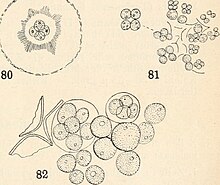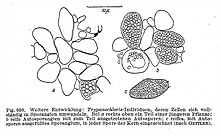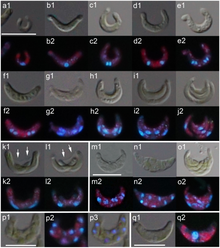Autospore

An autospore is a non-motile (non-flagellated) aplanospore that is produced within a parent cell, and has the same shape as the parent cell, before release.[1] Autospores, zoospores, and aplanospores, are the three types of spores that algae use to reproduce and spread asexually.[2] Autospores occur in several groups of algae, including Eustigmatophyceae, Dinoflagellates, and green algae. For example, the colonial alga Dichotomococcus produces two autospores per reproducing cell; the autospores escape through a slit in the cell wall and remain attached to the mother cell.[3]
Formation[edit]


Autospores are the daughter cells formed by the internal division of a single cell.[6] Autospores are formed as a result of fission in the mitotic phase of cell division of green algae. Fission in the mitotic phase of cell division of green algae forms autospores. Cells may use different methods to produce different numbers of autospores or multinucleated autospores; for example, the Dictyochloropsis genus of algae can produce between 4 and 16 autospores when they reproduce. The cell can undergo a multipartition after two rounds of fission as happens in Kirchneriella lunaris.[7] Pseudokirchneriella subcapitata follows a similar method of multiple fission after two nuclear divisions, which forms four autospores, but also has two other methods: binary fission, producing two autospores, or "two-autospore type," and multiple fission which produces eight autospores known as "eight-autospore type."[8] There are two stages of autospore formation. There is moderate synthesis during the process of cell growth. During the cell division stage, there is rapid synthesis. After being released from the cell's autosporangium, the cell will begin to synthesize a new daughter cell.
Autospores, zoospores, and aplanospores[edit]
Autospores are one of three kinds of spores which algae use to reproduce asexually.[2] Zoospores are flagellate and can move, whereas aplanospores and autospores are aflagellate.[5] Aplanospores and zoospores are produced endogenously, or internally.[9] Autospores are identical copies of the parent cell and cannot develop into zoospores. They are released through the rupturing of the parent cell wall.[2]
References[edit]
- ^ van den Hoek C, Mann DG, Jahns HM (1995). Algae: An Introduction to Phycology. Cambridge: Cambridge University Press. p. 455.
- ^ a b c "Reproduction in Algae". Biocyclopedia. Retrieved 20 April 2018.
- ^ Thompson RH (1952). "A New Genus and New Records of Algae in the Chlorococcales". American Journal of Botany. 39 (6): 365–367. doi:10.1002/j.1537-2197.1952.tb14287.x. JSTOR 2438780.
- ^ Pascher A (1939). Dr. L. Rabenhorst's Kryptogamen-Flora von Deutschland, Österreich und der Schweiz: Heterokonten. Leipzig: E. Kummer. p. 827. doi:10.5962/bhl.title.100894.
- ^ a b Anderson R, Lewin R (March 7, 2024). "algae". Britannica.
- ^ "Definition of AUTOSPORE". www.merriam-webster.com. Retrieved 2024-03-11.
- ^ Pickett-Heaps JD (1970-09-01). "Mitosis and autospore formation in the green algaKirchneriella lunaris". Protoplasma. 70 (3): 325–347. doi:10.1007/BF01275761. ISSN 1615-6102.
- ^ Yamagishi T, Yamaguchi H, Suzuki S, Horie Y, Tatarazako N (2017-02-02). "Cell reproductive patterns in the green alga Pseudokirchneriella subcapitata (=Selenastrum capricornutum) and their variations under exposure to the typical toxicants potassium dichromate and 3,5-DCP". PloS One. 12 (2): e0171259. Bibcode:2017PLoSO..1271259Y. doi:10.1371/journal.pone.0171259. PMC 5289587. PMID 28152022.
- ^ Lakna (May 19, 2017). "Difference Between Zoospores and Aplanospores". PEDIAA – via ResearchGate.
